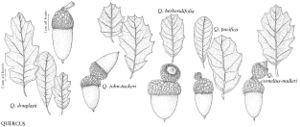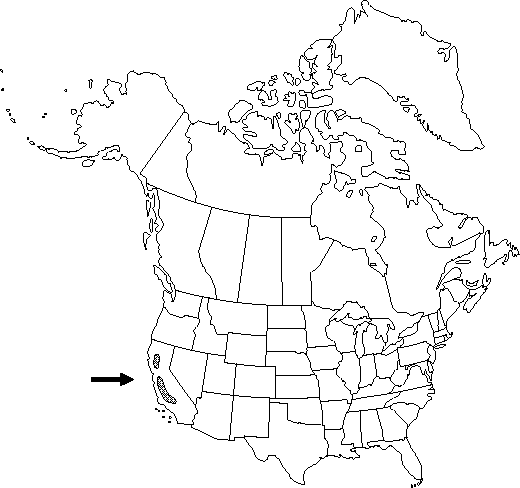Difference between revisions of "Quercus john-tuckeri"
Novon 4: 391. 1994.
imported>Volume Importer |
imported>Volume Importer |
||
| Line 58: | Line 58: | ||
|publication year=1994 | |publication year=1994 | ||
|special status=Endemic;Illustrated | |special status=Endemic;Illustrated | ||
| − | |source xml=https:// | + | |source xml=https://bitbucket.org/aafc-mbb/fna-data-curation/src/2e0870ddd59836b60bcf96646a41e87ea5a5943a/coarse_grained_fna_xml/V3/V3_701.xml |
|genus=Quercus | |genus=Quercus | ||
|section=Quercus sect. Quercus | |section=Quercus sect. Quercus | ||
Latest revision as of 21:50, 5 November 2020
Shrubs, subevergreen or evergreen, 1-3(-5) m. Bark light gray or brown, scaly. Twigs yellowish or dingy gray, 1-1.5(-2) mm diam., densely tomentulose. Buds brown, ovoid or globose, 1.5-2(-3) mm, glabrous except for ciliate margins of scales; proximal scales often yellowish puberulent. Leaves: petiole 1-4 mm. Leaf blade unicolored, elliptic or obovate, (10-)15-30(-40) × (8-)10-15(-20) mm, thick and leathery, often brittle, base truncate or rounded-attenuate, rarely subcordate, margins irregularly spinose-toothed, occasionally shallowly lobate, secondary veins (3-)4-7, often some veins branching near margin and passing into more than 1 tooth, apex acute or rounded; surfaces abaxially waxy grayish, light green, or yellowish, sparse to moderately dense (8-)10-12-rayed, (loosely) appressed-stellate hairs, often 0.2-0.5 mm diam., and sparse to crowded, yellowish, glandular hairs, adaxially dull grayish, with stellate hairs, similar to abaxial surface. Acorns solitary or paired, subsessile; cup cup-shaped or obconic to hemispheric, 5-7 mm deep × 10-15 mm wide, thin, scales whitish or yellowish, moderately or scarcely tuberculate, puberulent; nut fusiform, ovoid, or conic, 20-30 mm, apex acute. Cotyledons distinct.
Habitat: Dry slopes, chaparral, pinyon and juniper woodlands, margins of oak woodlands and sagebrush
Elevation: 900-2000 m
Discussion
Dry slopes, chaparral, pinyon and juniper woodlands, margins of oak woodlands and sagebrush; 900-2000 m; Calif.
Endemic to California, Quercus john-tuckeri occurs from Los Angeles County northward in the interior Coast Ranges and Sierra Foothills to the northern edge of Sacramento Valley.
Quercus john-tuckeri bears some resemblance to both Q. turbinella and Q. berberidifolia. Quercus turbinella has pedunculate fruit and cordate leaf bases, however, and Q. berberidifolia has a glabrate adaxial leaf surface, substantially smaller stellate trichomes with fewer rays on the abaxial leaf surface, heavier tuberculate acorn cups, and blunt or rounded (instead of acute) acorns.
Selected References
None.

